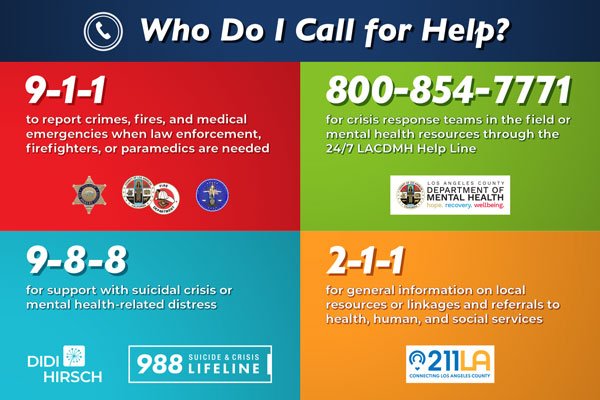To inform and educate the community about the differences between emergency and resource phone numbers in Los Angeles County, the Los Angeles County Department of Mental Health, in partnership with the Los Angeles County Fire Department, Sheriff’s Department, Los Angeles Police Department, 211 LA, and Didi Hirsch Mental Health Services, has launched the “Who Do I Call for Help?” awareness campaign.
The campaign provides easy-to-understand, illustrated definitions of each phone number (9-1-1, 9-8-8, 2-1-1, 1-800-854-7771) and its associated agencies and the services they can provide when a call is received. “Who Do I Call for Help?” campaign materials include social media graphics, posters, bookmarks and wallet-sized cards and are available in English and Spanish.
“When people are experiencing a crisis, there’s no one-size-fits-all solution,” said Janice Hahn, County Supervisor, District 4. “We want people to know there’s someone out there who can step in at the right time and provide the right assistance. We’ve worked hard to create those pathways, and now is the time to get that information out to communities across Los Angeles County.”
“Through our ‘Who Do I Call If I Need Help?’ campaign, we want residents to know that the County has a variety of appropriate resources to assist those with emergency situations or critical needs, especially those who require specialized mental health-related responses,” said LACDMH Director Dr. Lisa H. Wong. “By redirecting mental health-related calls from 9-1-1 to 9-8-8 and the 24/7 LACDMH helpline, we are able to provide alternative crisis response services provided by private, non-law enforcement agencies.”
“Contacting the right agency helps ensure the call is dispatched appropriately and redirects emergency personnel to other emergencies and incidents,” said Los Angeles County Fire Chief Anthony C. Marrone. “In fact, Los Angeles County Fire Department dispatchers respond to more than 449,000 calls per year via 911, with more than 12,000 of those calls being mental health-related. This campaign aims to provide clarity on which number to call for help.”
“For years, calling 911 has been a solution to many social issues and emergencies. We have seen a steady increase in mental health-related calls, leaving family and friends unsure of who to contact when a loved one is experiencing a mental health crisis,” said Los Angeles County Sheriff Robert Luna. “Knowing how to contact the right resources during a mental health crisis can save a life, and this joint effort will connect people with the right professionals because every second counts when an individual needs help.”
“Working to connect communities with the most appropriate service providers is essential to ensure that people experiencing a mental health crisis receive the most appropriate help,” said Los Angeles Police Acting Chief Dominic Choi. “We look forward to the success of the ‘Who Do I Call for Help?’ campaign. So far this year, we have already redirected 661 calls to 9-8-8 and handled 2,283 LAPD cases in our joint response program with LACDMH. We are confident this program will help ensure our community gets the support they need quickly and effectively.”
“Understanding the differences between emergency phone numbers is important to receiving the right care when you need it,” said Maribel Marin, executive director of 211 LA. “2-1-1 LA is available 24 hours a day, 7 days a week, directing Los Angeles County residents to a variety of resources tailored to their individual basic needs, from food resources, utility assistance and emergency shelter support to community services. Knowing when to call 9-1-1, 9-8-8 or 2-1-1 helps people get the right help faster and ensures our community has the right help when they need it most.”
“We want to remind Los Angeles County residents that they are not alone, and that 988 crisis counselors are ready to listen without judgment to their mental health concerns or suicidal thoughts,” said Didi Hirsch CEO Lynn Morris. “We thank the Los Angeles County Department of Mental Health for raising awareness of 988 and other important resources.”
For more information about the “Who Can I Ask for Help?” awareness campaign and to download materials (including posters, bookmarks and social media posts), visit the LACDMH website. Limited quantities of “Who Can I Ask for Help?” bookmarks are available in English and Spanish at Los Angeles County Library branches.
For more information, visit dmh.lacounty.gov or follow @LACDMH on Facebook, Twitter (X), Instagram and YouTube.

